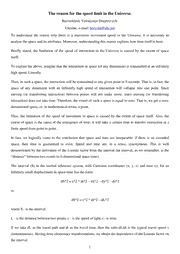
The reason for the speed limit in the Universe. PDF
Preview The reason for the speed limit in the Universe.
The reason for the speed limit in the Universe. Bezverkhniy Volodymyr Dmytrovych. Ukraine, e-mail: [email protected] To understand the reason why there is a maximum movement speed in the Universe, it is necessary to analyze the space and its attributes. Moreover, understanding this reason explains how time itself is born. Briefly stated, the limitation of the speed of interaction in the Universe is caused by the extent of space itself. To explain the above, imagine that the interaction in space (of any dimension) is transmitted at an infinitely high speed. Literally. Then, in such a space, the interaction will be transmitted to any given point in 0 seconds. That is, in fact, the space of any dimension with an infinitely high speed of interaction will collapse into one point. Since moving (or transferring interaction) between points will not make sense, since moving (or transferring interaction) does not take time. Therefore, the extent of such a space is equal to zero. That is, we get a zero- dimensional space, or, in mathematical terms, a point. Thus, the limitation of the speed of movement in space is caused by the extent of space itself. Also, the extent of space is the cause of the emergence of time: it will take a certain time to transfer interaction at a finite speed from point to point. In fact, we logically came to the conclusion that space and time are inseparable: if there is an extended space, then time is guaranteed to exist. Speed and time are, in a sense, synonymous. This is well demonstrated by the derivation of the Lorentz factor from the interval (an interval, as we remember, is the “distance” between two events in 4-dimensional space-time). The interval (S) in the inertial reference system, with Cartesian coordinates (x, y, z) and time (t), for an infinitely small displacement in space-time has the form: dS^2 = c^2 * dt^2 – dx^2 – dy^2 – dz^2 or dS^2 = c^2 * dt^2 – dL^2 where S - is the interval, L - is the distance between two points, c - is the speed of light, t - is time. If we take dL as the travel path and dt as the travel time, then the ratio dL/dt is the typical travel speed v (instantaneous). Having done elementary transformations, we obtain the dependence of the Lorentz factor on the interval. 1 dS^2/dt^2 = c^2 – dL^2/dt^2 dS^2/dt^2 = c^2 – v^2 1/c^2 * dS^2/dt^2 = 1 – v^2/c^2 1/c * dS/dt = (1 – v^2/c^2)^0.5 dS/dt = c * (1 – v^2/c^2)^0.5 ϒ = 1/ (1 – v^2/c^2)^0.5 = c * dt/dS where ϒ - is the Lorentz factor. 1/ (1 – v^2/c^2)^0.5 = c * dt/dS 1/(c * (1 – v^2/c^2)^0.5) = dt/dS As we can see from the last formula, if we have velocity (left side of the equation), then we have space-time continuum (right side of the equation). It is interesting to note that no matter what dimension the space will be (1, 2, 3, etc.), time will “arise” automatically with the extent of this space. In addition, if we have an isotropic space (the same properties of space in all directions), this automatically leads us to infinite space, more precisely space-time. Since there can be no “edge” of space. Therefore, our Universe is infinite in time and space. 2
